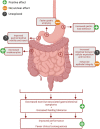The Effect of Gut-Training and Feeding-Challenge on Markers of Gastrointestinal Status in Response to Endurance Exercise: A Systematic Literature Review
- PMID: 37061651
- PMCID: PMC10185635
- DOI: 10.1007/s40279-023-01841-0
The Effect of Gut-Training and Feeding-Challenge on Markers of Gastrointestinal Status in Response to Endurance Exercise: A Systematic Literature Review
Abstract
Background: Nutrition during exercise is vital in sustaining prolonged activity and enhancing athletic performance; however, exercise-induced gastrointestinal syndrome (EIGS) and exercise-associated gastrointestinal symptoms (Ex-GIS) are common issues among endurance athletes. Despite this, there has been no systematic assessment of existing trials that examine the impact of repetitive exposure of the gastrointestinal tract to nutrients before and/or during exercise on gastrointestinal integrity, function, and/or symptoms.
Objective: This systematic literature review aimed to identify and synthesize research that has investigated the impact of 'gut-training' or 'feeding-challenge' before and/or during exercise on markers of gastrointestinal integrity, function, and symptoms.
Methods: Five databases (Ovid MEDLINE, EMBASE, CINAHL Plus, Web of Science Core Collection, and SPORTDiscus) were searched for literature that focused on gut-training or feeding-challenge before and/or during exercise that included EIGS and Ex-GIS variables. Quality assessment was conducted in duplicate and independently using the Cochrane Collaboration's risk-of-bias (RoB 2) tool.
Results: Overall, 304 studies were identified, and eight studies were included after screening. Gut-training or feeding-challenge interventions included provision of carbohydrates only (n = 7) in various forms (e.g., gels or liquid solutions) during cycling or running, or carbohydrate with protein (n = 1) during intermittent exercise, over a varied duration (4-28 days). Gut discomfort decreased by an average of 47% and 26% with a 2-week repetitive carbohydrate feeding protocol (n = 2) and through repeated fluid ingestion over five trials (n = 1), respectively. Repetitive carbohydrate feeding during exercise for 2 weeks resulted in the reduction of carbohydrate malabsorption by 45-54% (n = 2), but also led to no significant change (n = 1). The effect of gut-training and feeding-challenges on the incidence and severity of Ex-GIS were assessed using different tools (n = 6). Significant improvements in total, upper, and lower gastrointestinal symptoms were observed (n = 2), as well as unclear results (n = 4). No significant changes in gastric emptying rate (n = 2), or markers of intestinal injury and permeability were found (n = 3). Inconclusive results were found in studies that investigated plasma inflammatory cytokine concentration in response to exercise with increased carbohydrate feeding (n = 2).
Conclusions: Overall, gut-training or feeding-challenge around exercise may provide advantages in reducing gut discomfort, and potentially improve carbohydrate malabsorption and Ex-GIS, which may have exercise performance implications.
© 2023. The Author(s).
Conflict of interest statement
Isabel Martinez, Alice Mika, Jessica Biesiekierski, and Ricardo Costa declare that they have no conflicts of interest relevant to the content of this review.
Figures



Similar articles
-
Two weeks of repetitive gut-challenge reduce exercise-associated gastrointestinal symptoms and malabsorption.Scand J Med Sci Sports. 2018 Feb;28(2):630-640. doi: 10.1111/sms.12912. Epub 2017 Jun 19. Scand J Med Sci Sports. 2018. PMID: 28508559 Clinical Trial.
-
The impact of 48 h high carbohydrate diets with high and low FODMAP content on gastrointestinal status and symptoms in response to endurance exercise, and subsequent endurance performance.Appl Physiol Nutr Metab. 2024 Jun 1;49(6):773-791. doi: 10.1139/apnm-2023-0508. Epub 2024 Feb 15. Appl Physiol Nutr Metab. 2024. PMID: 38359412
-
Gut-training: the impact of two weeks repetitive gut-challenge during exercise on gastrointestinal status, glucose availability, fuel kinetics, and running performance.Appl Physiol Nutr Metab. 2017 May;42(5):547-557. doi: 10.1139/apnm-2016-0453. Epub 2017 Mar 22. Appl Physiol Nutr Metab. 2017. PMID: 28177715 Clinical Trial.
-
Effect of prebiotics, probiotics, and synbiotics on gastrointestinal outcomes in healthy adults and active adults at rest and in response to exercise-A systematic literature review.Front Nutr. 2022 Dec 7;9:1003620. doi: 10.3389/fnut.2022.1003620. eCollection 2022. Front Nutr. 2022. PMID: 36570133 Free PMC article.
-
A Food First Approach to Carbohydrate Supplementation in Endurance Exercise: A Systematic Review.Int J Sport Nutr Exerc Metab. 2022 Mar 1;32(4):296-310. doi: 10.1123/ijsnem.2021-0261. Print 2022 Jul 1. Int J Sport Nutr Exerc Metab. 2022. PMID: 35231883
Cited by
-
Joint association of frailty and depression with new-onset digestive disease among elderly Chinese population.Front Nutr. 2025 Jul 28;12:1590194. doi: 10.3389/fnut.2025.1590194. eCollection 2025. Front Nutr. 2025. PMID: 40791236 Free PMC article.
-
A Review of Carbohydrate Supplementation Approaches and Strategies for Optimizing Performance in Elite Long-Distance Endurance.Nutrients. 2025 Mar 6;17(5):918. doi: 10.3390/nu17050918. Nutrients. 2025. PMID: 40077786 Free PMC article. Review.
-
Nutritional strategies for minimizing gastrointestinal symptoms during endurance exercise: systematic review of the literature.J Int Soc Sports Nutr. 2025 Dec;22(1):2529910. doi: 10.1080/15502783.2025.2529910. Epub 2025 Jul 11. J Int Soc Sports Nutr. 2025. PMID: 40650376 Free PMC article. Review.
-
Any old iron, man.Exp Physiol. 2025 Jan;110(1):6-10. doi: 10.1113/EP092295. Epub 2024 Oct 28. Exp Physiol. 2025. PMID: 39463270 Free PMC article. No abstract available.
-
Decoding Ultramarathon: Muscle Damage as the Main Impediment to Performance.Sports Med. 2025 Mar;55(3):535-543. doi: 10.1007/s40279-024-02127-9. Epub 2024 Oct 15. Sports Med. 2025. PMID: 39405022 Review.
References
-
- Costa RJS, Hoffman MD, Stellingwerff T. Considerations for ultra-endurance activities: part 1- nutrition. 2018;27:166–81. 10.1080/15438627.2018.1502188. - PubMed
-
- Costa R, Miall A, Khoo A, Rauch C, Snipe R, Camões-Costa V, et al. Gut-training: the impact of two weeks repetitive gut-challenge during exercise on gastrointestinal status, glucose availability, fuel kinetics, and running performance. Appl Physiol Nutr Metab. 2017;42:547–557. doi: 10.1139/apnm-2016-0453. - DOI - PubMed
Publication types
MeSH terms
Substances
LinkOut - more resources
Full Text Sources

